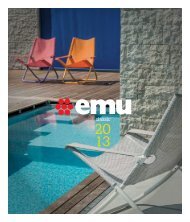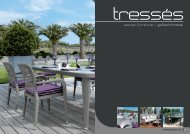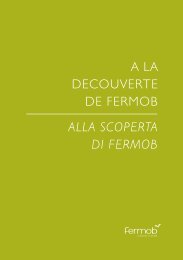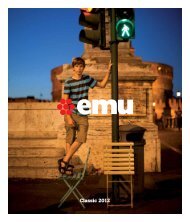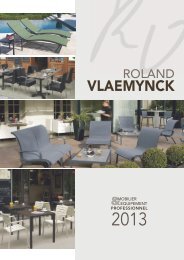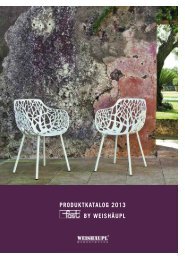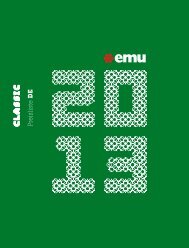ELEMEnTS - Jardin-Confort
ELEMEnTS - Jardin-Confort
ELEMEnTS - Jardin-Confort
Create successful ePaper yourself
Turn your PDF publications into a flip-book with our unique Google optimized e-Paper software.
luestone<br />
tabletops (stone)<br />
bluestone<br />
light<br />
bl<br />
bluestone<br />
dark<br />
bd<br />
SATINGO blue<br />
SB<br />
(1)<br />
white veins<br />
Belgian bluestone or “Little Granite” is a limestone with a more or less pronounced natural blue/grey colour, which is characterized by the presence of a large<br />
number of fossilized crinoids. This type of bluestone is only quarried in Belgium.<br />
• It develops a natural patina:<br />
use: outdoors, changes due to the action of rain and UV-rays<br />
to its original pale blue-grey colour<br />
use : indoors in the course of time, it develops a deeper colour<br />
• Bluestone is susceptible to products and scratches<br />
• Belgian bluestone can often contain a number of white veins (1),<br />
black lines, spots and fossils (2)<br />
• Depending on the finishing, the stone has a different look<br />
(1) “White veins” are water veins, formed by water, 100% specific to bluestone and are not cracks as people often assume.<br />
(2) Fossils and colour differences: stone is a natural material formed by different perfectly petrified fossils. So it is normal to find nests of crustaceans in the<br />
stone. In other words, even in one sheet of stone clear differences in colour can be observed.<br />
(2)<br />
fossils<br />
BLUESTONE text is based on a publication by the WTCB<br />
(Wetenschappelijk en Technisch Centrum voor het Bouwbedrijf - Building Industry Scientific and Technical Centre)<br />
granite<br />
Granite Dark (GD) and Polish (GP) have a much more regular<br />
structure than bluestone<br />
• Much less absorbent structures than bluestone<br />
• Virtually no veins in the surface<br />
• Easier to maintain than bluestone<br />
granite dark<br />
gd<br />
granite polish<br />
gp<br />
GRANITE TINTA<br />
GT<br />
Granite Caramel (GC) quartzite (layered structure)<br />
Colour variations (3) and general comments: in stone terminology, it would be described as rather uniform, an orangey brown, which can change from lightcoloured<br />
to considerably darker with a subtle cloud and line structure, sometimes having a greyish background. Occasionally, a dark-brown pattern or shape<br />
occurs in the stone, and sporadically, pitting or flaking is possible.<br />
Granite Tinta (GT) Is a porous, silicon-containing sand stone<br />
• Colour can vary from light grey to darker greyish blue<br />
• In rare cases this stone can contain small holes,<br />
sparkling spots or darkgrey to black speckled structures<br />
• It is absolutely necessary to impregnate this stone<br />
(cf. Manutti Care Line)<br />
• Is acid and scratch sensitive<br />
GRANITE<br />
CARAMEL<br />
GC<br />
SATINGO nero<br />
SN<br />
Satingo Nero (SN) is a granit-like stone<br />
• Is black-coloured with nuances in the black colour structures<br />
• Can be lightly spotted<br />
• Can contain minuscule holes<br />
• It is advisable to impregnate this stone (cf. Manutti Care Line)<br />
PIERRE DE PROVENCE<br />
marble white<br />
SATINGO SAND<br />
SS<br />
Pierre de Provence is a French porous limestone.<br />
It always contains sandy areas or pits in the surface<br />
Typical characteristics: a deep beige colour with structural variations,<br />
with whitish grey/black fossils.<br />
marble white<br />
MW<br />
Carrara marble is a flawless marble from the marble quarries of the Apuan<br />
Alps. Its application possibilities are varied. The Bianco Carrara marble has<br />
predominantly a white to light gray background. On its surface, darker shades<br />
of gray veining are featured. Like all natural stones, Carrara marble varies from<br />
piece to piece and from lot to lot.<br />
• Each marble plate has its own unique shading<br />
• Small white spots and tiny holes may appear on the surface<br />
• Is frost resistant<br />
138<br />
general information<br />
G/a/s



